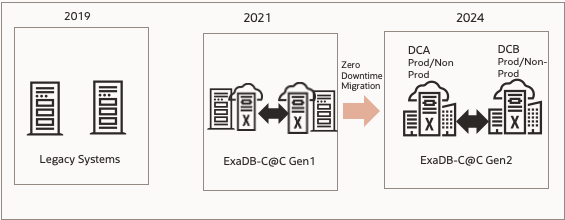UHN is Canada’s number 1 hospital and the world’s number 1 publicly funded hospital. With 10 sites and more than 20,000 members of TeamUHN, UHN consists of Toronto General Hospital, Toronto Western Hospital, Princess Margaret Cancer Centre, Toronto Rehabilitation Institute, The Michener Institute of Education at UHN and West Park Healthcare Centre. As Canada’s top research hospital, the scope of research and complexity of cases at UHN have made it a national and international source for discovery, education, and patient care. To maintain high standards, UHN’s IT infrastructure required an update, particularly regarding server hardware. By 2019, the servers were approaching the end of their useful life. To continue supporting and enhancing the performance of the Oracle databases, UHN decided to implement Oracle Exadata Cloud@Customer Generation 1.
Tommy Liu, who began his role as Director of Data Engineering at UHN during the migration to Exadata Cloud@Customer Gen1, played a key role in this transition.
Before Exadata Cloud@Customer
The legacy servers were no longer supported, leading to system disruptions and increased costs. Adopting Exadata Cloud@Customer marked UHN’s first mover into the cloud, bringing not only a new server system but also significant changes in system maintenance. Previously, the database team was responsible for infrastructure patching, managing security updates, and determining the best times for implementation. With the transition to the cloud, these responsibilities were shifted to Oracle, representing a major change in their workflow and mindset.

The Migrations
UHN managed both migrations independently. Leveraging their in-house Oracle expertise and strong partnership with Oracle’s sales team, Tommy Liu assembled a top-notch project management team.
Tommy’s team used a straightforward but effective approach:
- Engage all stakeholders: Ensure everyone involved or affected is included.
- Understand the impact: Assess how the migration will affect operations.
- Minimize downtime: Schedule disruptions only during weekends.
- Analyze the process: Clearly understand each step of the migration.
- Communicate thoroughly: Keep stakeholders informed, especially during application shutdowns.
- Verify functionality: Check connections streams and database functionality after migration.
The benefits UHN realized from migrating to Exadata Cloud@Customer Gen1 were so significant that moving to Gen2 became a logical next step as the contract approached its end. The transition to Exadata Cloud@Customer Gen2 allowed for UHN to reduce OCPU requirements and costs while benefiting from enhanced performance with the newer technology.
The second migration, from Exadata Cloud@Customer Gen1 to Gen2, was expedited using Oracle’s Zero Downtime Migration tool. This tool, designed for migrating Oracle databases within Oracle infrastructure, minimized the impact on applications.
UHN migrated most of their clinical application databases, including clinical patient information, treatment data, and medication records, to Exadata Cloud@Customer. Additionally, their HR systems and Data Warehouse database are hosted on Exadata Cloud@Customer
Organizational impact of Exadata Cloud@Customer
The main advantage of Exadata Cloud@Customer that Tommy Liu, Director of Data Engineering, identified was the change in maintenance of the systems. Since UHN does not own the servers, Oracle is responsible for maintaining the infrastructure. UHN’s DBA team only needs to take care of the databases themselves, which means reduced maintenance work for Tommy’s team, enhancing their job quality.
Additional benefits achieved include the ability to migrate all old Oracle instances off of legacy systems, the flexibility of the system, being able to scale up during peak times, using the system’s power, and scaling back down when the load allowed. This also reduced costs.
Next Steps & Resumé
When asked what the next steps would be, Tommy answered that Autonomous is being considered. Here, some planning and evaluation are needed, especially a better understanding of which databases can be easily migrated to Autonomous.
Generative AI is another topic, especially for analytics, that is being considered, but the team needs to understand and investigate how to leverage this technology.
A piece of advice for companies considering moving to Exadata Cloud@Customer:
The approach depends on different organizations. Start by testing Autonomous, trying to understand the tools and capabilities, getting comfortable with the technology, and developing a general strategy for migrating.


